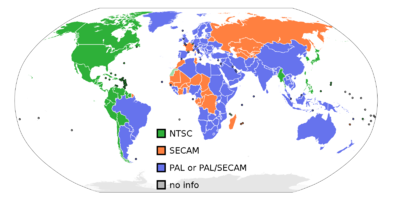List of regional version differences (disambiguation): Difference between revisions
m (Rtzxy moved page List of regional version differences to List of regional version differences (disambiguation): No disambiguation.) |
MuteSpittah (talk | contribs) (may be a bit meaty for a disambig but it does the job) |
||
| Line 1: | Line 1: | ||
{{ArticleIcons|series=y}} | {{ArticleIcons|series=y}} | ||
Each game in the [[Super Smash Bros. series|''Super Smash Bros.'' series]] has its own '''list of regional version differences''': | Each game in the [[Super Smash Bros. series|''Super Smash Bros.'' series]] has its own '''list of regional version differences'''. | ||
[[File:PAL-NTSC-SECAM.png|thumb|400px|Regions of the world which used the different encoding systems]] | |||
Many games developed in Japan usually see a Japanese release first. These usually have different text, names, sounds, and minor aesthetic changes from the NTSC and PAL versions. The initial Japanese release of the game may naturally come with some initial bugs, and minor to major changes may be seen in future regional releases. | |||
Within the video gaming community, "'''NTSC'''" refers to the region of North America and small parts of South America and Asia. The term comes from the analog television encoding system '''National Television System Committee''', the primary method of encoding analog TV for North America, South America, and Japan. NTSC is most commonly used as shorthand for "the North American version of a game". Historically, North America is usually the second region for games made in Japan to be released, as only an English translation is necessary for arguably the most important overseas market. As a result, NTSC releases are often the second version of the game, with major bugs fixed and possibly minor changes added. | |||
"'''PAL'''" is a term referring to the region of Europe, Asia (minus Japan), Africa, most of South America, and Australia. The term comes from the analog television encoding system '''Phase Alternate Line''', the primary method of encoding analog TV for these parts of the world. PAL is most commonly used as shorthand for "the European version of a game". Historically, Europe is usually the third and final region for games made in Japan to be released, as games have to be translated into several languages, a process that takes both more time and more space than the [[NTSC]] region. In addition, due to cultural differences, the English translation cannot always be simply copied from the American version of the game. As a result, PAL releases are often the final version of the game, with all known bugs fixed and possibly significant changes added. | |||
* [[List of regional version differences (SSB)]] | * [[List of regional version differences (SSB)]] | ||
Revision as of 04:01, March 9, 2016
Each game in the Super Smash Bros. series has its own list of regional version differences.
Many games developed in Japan usually see a Japanese release first. These usually have different text, names, sounds, and minor aesthetic changes from the NTSC and PAL versions. The initial Japanese release of the game may naturally come with some initial bugs, and minor to major changes may be seen in future regional releases.
Within the video gaming community, "NTSC" refers to the region of North America and small parts of South America and Asia. The term comes from the analog television encoding system National Television System Committee, the primary method of encoding analog TV for North America, South America, and Japan. NTSC is most commonly used as shorthand for "the North American version of a game". Historically, North America is usually the second region for games made in Japan to be released, as only an English translation is necessary for arguably the most important overseas market. As a result, NTSC releases are often the second version of the game, with major bugs fixed and possibly minor changes added.
"PAL" is a term referring to the region of Europe, Asia (minus Japan), Africa, most of South America, and Australia. The term comes from the analog television encoding system Phase Alternate Line, the primary method of encoding analog TV for these parts of the world. PAL is most commonly used as shorthand for "the European version of a game". Historically, Europe is usually the third and final region for games made in Japan to be released, as games have to be translated into several languages, a process that takes both more time and more space than the NTSC region. In addition, due to cultural differences, the English translation cannot always be simply copied from the American version of the game. As a result, PAL releases are often the final version of the game, with all known bugs fixed and possibly significant changes added.
- List of regional version differences (SSB)
- List of regional version differences (SSBM)
- List of regional version differences (SSBB)
- List of regional version differences (SSB4)

